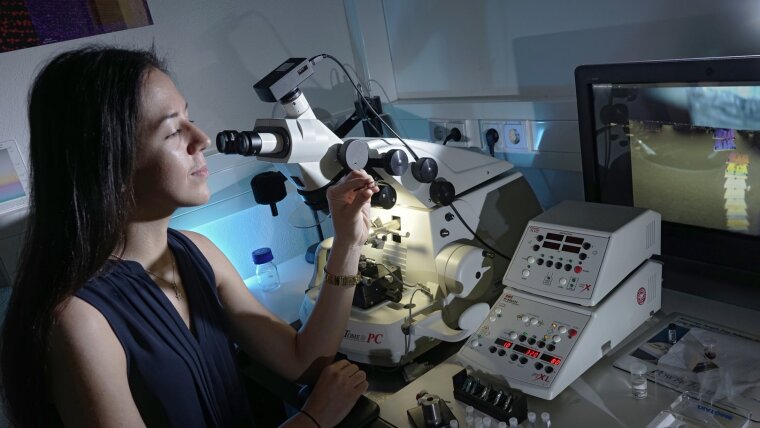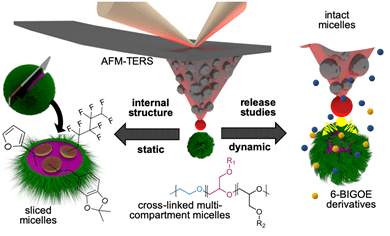
For controlled drug release from nanocarriers at a desired physiological target site, in-depth knowledge about the structure of the respective nanocarrier and/or the location of the desired cargo is crucial. With respect to these targets, project B04, in the first funding period, developed the methods for high resolution investigation of the composition of polymer nanoparticles and core-corona block copolymer micelles using combinations of near-field optical vibrational spectroscopic- (AFM-TERS, tip-enhanced Raman scatttering) and nanomechanical information (FD-AFM, force-distance AFM). These developments allow to distinguish minute differences in elasticity and adhesion across nanoparticles and can eventually be correlated with the structural components even down to single monomeric units, either of the used block copolymers or unreacted compounds like linker molecules. Novel embedding and slicing as well as freeze-fracturing procedures have been established for model nanoparticles and polyether-based block copolymer micelles allowing to clearly distinguish core and shell composition of the two-phase systems. In addition the derived correlative application of far-field and near-field Raman spectroscopy proved to be an essential tool for the general investigation of bulk and surface composition of nanoparticles in general. Very successful was the application of the above mentioned nanomechanical experiments in combination with TERS, as in this way adhesion and elasticity could be correlated with structural evidence of hydrophobicity / hydrophylicity on the nanometer scale.
In the second funding period, B04 will shift the focus from model systems towards the investigation of fundamental parameters linked to drug release mechanisms as well as to the monitoring of the location and distribution of different drugs within single block copolymer micelles, including structures where the core is even further compartmentalized. The nanoscale investigation of dynamic processes (e.g. induced structural changes or diffusion processes) on single nanoparticles will also support and at the same time profit from mesoscale simulations of drug release processes, directly linking theoretical and experimental results on mesoscopic scales. Selective and reversible crosslinking of specific domains, e.g. using disulfide- or bis-boronic acid-based crosslinking as well as response towards changes in temperature, pH-value, or even light will further be investigated to understand structural changes of the carrier material, which is ultimately required to actively release components. Moreover, we will investigate the simultaneous encapsulation of two different model drugs in adjacent compartments of micellar cores featuring different polarity, e.g. fluorinated / hydrophobic. Clearly, the experimental approaches established specifically for the polymer nanoparticles in the first funding period, which comprise techinques with nanometer spatial resolution and the high chemical specificity form an important pillar and will be the basis of the nanometer scale phenomenological and structural investigations. However, studying drug release mechanisms this time, a transfer to more realistic and experimentally demanding conditions, like liquid environments, temperature changes or variations in the chemical composition of the environment will be pursued. Consequently, our target is to provide a dynamic structural investigation of changes in polymeric nanoparticles and the respective interaction with any incorporated cargo to gain a fundamental understanding of the underlying processes.
Grafik Projekt B04
Graphic: F. Schacher/V. DeckertProf. Dr. Felix H. Schacher
Image: Anne Günther (University of Jena)Prof. Dr. Felix H. Schacher
Laboratory of Organic and Macromolecular Chemistry (IOMC)
Friedrich Schiller University Jena
Humboldtstraße 10
07743 Jena
Phone: +49 3641 9-48250
felix.schacher@uni-jena.de
Andreas Stihl
Image: Andreas StihlAndreas Stihl
Laboratory of Organic and Macromolecular Chemistry (IOMC)
Friedrich Schiller University Jena
Humboldtstraße 10
07743 Jena
andreas.stihl@uni-jena.de



